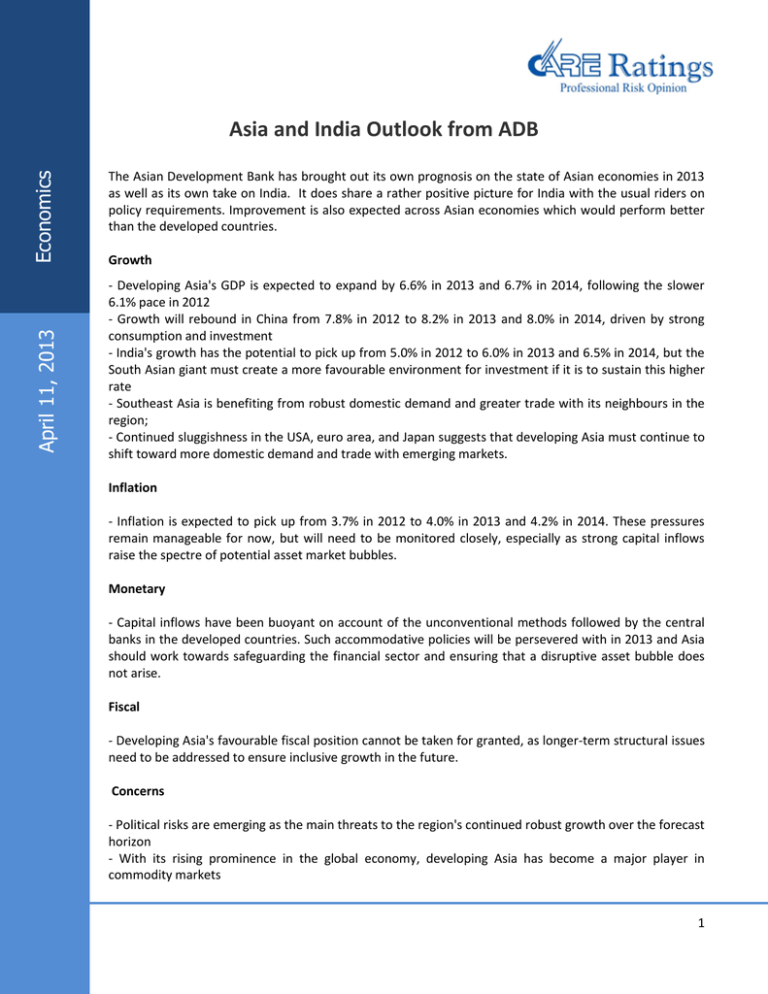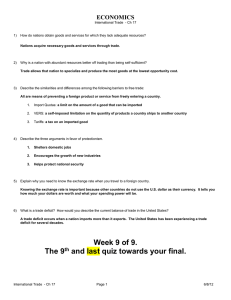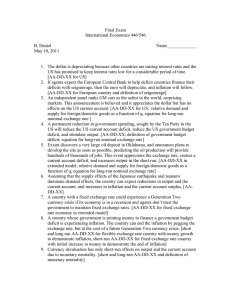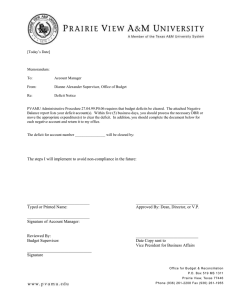Asia and India Outlook from ADB s ic
advertisement

Asia and India Outlook from ADB Economics The Asian Development Bank has brought out its own prognosis on the state of Asian economies in 2013 as well as its own take on India. It does share a rather positive picture for India with the usual riders on policy requirements. Improvement is also expected across Asian economies which would perform better than the developed countries. Growth - April 11, 2013 - - - - - Developing Asia's GDP is expected to expand by 6.6% in 2013 and 6.7% in 2014, following the slower 6.1% pace in 2012 - Growth will rebound in China from 7.8% in 2012 to 8.2% in 2013 and 8.0% in 2014, driven by strong consumption and investment - India's growth has the potential to pick up from 5.0% in 2012 to 6.0% in 2013 and 6.5% in 2014, but the South Asian giant must create a more favourable environment for investment if it is to sustain this higher rate - Southeast Asia is benefiting from robust domestic demand and greater trade with its neighbours in the region; - Continued sluggishness in the USA, euro area, and Japan suggests that developing Asia must continue to shift toward more domestic demand and trade with emerging markets. Inflation - Inflation is expected to pick up from 3.7% in 2012 to 4.0% in 2013 and 4.2% in 2014. These pressures remain manageable for now, but will need to be monitored closely, especially as strong capital inflows raise the spectre of potential asset market bubbles. Monetary - Capital inflows have been buoyant on account of the unconventional methods followed by the central banks in the developed countries. Such accommodative policies will be persevered with in 2013 and Asia should work towards safeguarding the financial sector and ensuring that a disruptive asset bubble does not arise. - Fiscal - Concerns - - Developing Asia's favourable fiscal position cannot be taken for granted, as longer-term structural issues need to be addressed to ensure inclusive growth in the future. - Political risks are emerging as the main threats to the region's continued robust growth over the forecast horizon - With its rising prominence in the global economy, developing Asia has become a major player in commodity markets 1 Economics - Developing Asia's energy needs will expand in tandem with its growing economic influence, but its own endowment is insufficient Expanding renewable energy sources will prove to be inadequate to meet future demand. Consequently, Asia needs to invest in making conventional power cleaner with increased efficiency Asia must aspire to the degree of regional cooperation and integration in energy by 2030 that currently prevails in Europe. Analysis of India’s performance during FY13 Economic growth in FY13 decelerated to 5%. Declining industrial growth and a downdraft in investment continued from FY12. The downturn was exacerbated by a slump in services activity, weakening consumption, and contracting exports. Growth in consumption halved from previous years’ average to 4.1% as private and public spending both dropped. Subdued economic activity, high inflation, a weak currency and steep interest rates dented consumer confidence. The slowdown in public consumption reflected the containment of government expenditure in the second half of FY13 to restrain the budget deficit. Supply bottlenecks such as lack of availability of fuel for power generation, difficulty in acquiring land and environmental clearances, contentious tax policies, and procedural delays continued to stifle investment, causing growth in fixed investment to drop to 2.5%. Delays over land and environmental clearances continued to hamper mining operations, keeping growth tepid at 0.4% despite a low base. Dwindling production of natural gas at a large new field caused by pricing and technical issues, and a lack of new discoveries in recent years drove natural gas production down by 13.3%. Electricity production also moderated as thermal generation was hampered by inadequate coal supplies and hydro generation was affected by depleted reservoirs following deficient rains. Consequently, power shortages have raised firms’ costs and hampered production. At the same time, there was deterioration in credit quality. Nonperforming and restructured loans are estimated to have increased to 9.5% of total loans and advances in September 2012 from 5.5% in March 2011.The fall in asset quality increased banks’ risk aversion and prompted portfolio switching from credit creation to investments in government securities, facilitated by large market borrowings by the government. Despite the economic slowdown, the central government budget deficit for FY13 was contained at 5.2% of GDP, well below the deficit of 5.7% in FY12 but marginally above the 5.1% target. However, the quality of the fiscal consolidation is a concern. In a bid to rein in the deficit, capital expenditure was compressed and grew by only 5.8%, against the original target of 29.2%. Thus, even though the overall deficit nearly reached its target, the revenue deficit exceeded the budgeted target by 0.5% of GDP. The current account deficit for FY13 is estimated at 5% of GDP, significantly higher than last year’s record, driven by a deteriorating trade balance. Despite a weak currency, merchandise exports contracted by 4%, because of weak global demand, down to $297.4 billion. While in previous years the worsening trade deficit was cushioned by improvement in invisibles, FY13 witnessed moderation in the invisibles’ surplus, driven by anaemic expansion in software and business services exports and remittances, and higher investment income payments. Spurred by announcements of various reform initiatives, portfolio flows picked up in the second half of the year to reach an estimated $26 billion in FY13. This helped the Indian rupee to strengthen after June 2012, but it nevertheless depreciated in FY13 by 7.5% against the US dollar, and the real effective exchange rate fell by about 5%. Global Update: ADB’s Asia and India Outlook 2 Economics FY14 outlook Progress on reforms in FY14 is expected to improve business and consumer confidence sufficiently to underpin a moderate improvement in investment and consumer spending. - An upturn in global trade volume and greater budgeted government spending would add to total demand. - With demonstrated results from planned measures to reduce the budget deficit, especially progress on reducing fuel subsidies, the central bank will further ease monetary policy, which would help to sustain and build demand momentum. - A normal monsoon is expected to substantially boost agriculture growth from the depressed base a year earlier. This will strengthen rural consumer demand and ease price pressures. - Industry growth should improve on better domestic and external demand, but unresolved structural issues will continue to constrain investment, mining, and power. - Services are expected to see a stronger pickup in activity than industry, though growth will continue to be restrained by the limited demand. o However, community services could see an uptick with increased government spending in the run-up to an election. In this scenario, GDP growth nudges up to 6% in FY2013. Improved global prospects, some easing of price pressures, and forward movement in resolving structural bottlenecks would allow growth to increase to 6.5% in FY15. Inflation would be more tolerable. - Core inflation pressures have receded considerably reflecting the lagged impact of monetary tightening and the slowdown in economic activity. At less than 5%, core inflation is in line with the RBI’s target. - A normal monsoon, fiscal consolidation, and easing global commodity prices will bring some reduction in price pressures. - Some elements of WPI inflation will remain sticky. Rising input costs, robust agricultural wage growth, higher minimum support prices for crops, and continuing undersupply of protein-rich products, fruits, and vegetables will keep food inflation elevated. - The direct and indirect effects of the decision to allow diesel prices to be raised in a series of small steps until losses are eliminated will exert upward pressure on prices. Consequently, average inflation is expected to decline only slightly in FY14 to 7.2%. Inflation in FY15 is expected to moderate to 6.8% with the effort to raise diesel prices completed and having worked through the economy, and with some forward movement in addressing supply-side bottlenecks affecting agriculture. Fiscal scene - The central government plans for its budget deficit to fall to 4.8% of GDP in FY2013, mainly through enhanced revenue collection. - However, with the tax structure remaining largely unchanged, apart from higher surcharges on earnings above a threshold and higher excise and custom duties on select items, revenue targets depend heavily on growth picking up. - Revenue from disinvestment and spectrum allocation is set well above the average of previous years. Meeting these magnitudes would depend on favorable market conditions. - The adequacy of the allocation for subsidies depends critically on the government’s willingness to continue regular revisions of diesel prices and to adjust the price of urea. Global Update: ADB’s Asia and India Outlook 3 Economics o Adverse developments from baseline assumptions on global prices of crude oil and fertilizers are risks, as is the exchange rate. Similarly, the actual requirement for food subsidies will be determined by the extent of increases in MSPs, the timing of the introduction of entitlements under the proposed National Food Security Act, and its scope. Trade Despite sluggish growth in the advanced economies, global trade volume is expected to revive and grow by 4% in 2013. The first signs of this were seen in increases in India’s exports in January and February after 9 months of declines measured year on year. Given the low base and a record of taking advantage of market opportunities, exports are projected to grow by 8% in FY14. Despite economic growth picking up marginally in FY2013, import demand will continue to be strong at 6% given India’s growing dependence on imports of crude oil, coal, metals and fertilizers. With no major improvement expected in net services and remittances, rising income payments will continue to limit the invisibles surplus. Accordingly, the current account deficit is forecast to improve to 4.4% of GDP in FY14. An uptick in domestic growth will boost imports by 16% in FY15. At the same time, stronger growth prospects in the advanced economies is expected to support further expansion in exports by 14%, facilitating an improvement in the current account deficit to 3.7% of GDP. Overall, the current account deficit is expected to be adequately financed by capital flows with some drawdown of reserves in case of a shortfall. What are the risk factors? - The global recovery continues to be weak, and significant risks arise from unresolved fiscal issues in the US and the possibility of financial shocks in euro area. Weak monsoons would shave agriculture growth and dent rural consumption. Delays in fiscal consolidation and slow progress in addressing some of the structural bottlenecks would damage confidence and hamper growth prospects. The supply side constraints and policy disarrays that have stalled domestic industrial and investment activity have also hindered exports. There is concern over the pattern of financing the current account deficit, as the share of financing occupied by stable FDI inflows has fallen below 30% since the global financial crisis, from over 80% earlier. Contact: Madan Sabnavis Chief Economist Madan.sabnavis@careratings.com 91-022-67543489 Jyoti Wadhwani Associate Economist Jyoti.wadhwani@careratings.com 91-022-67543407 Disclaimer This report is prepared by the Economics Division of Credit Analysis & Research Limited [CARE]. CARE has taken utmost care to ensure accuracy and objectivity while developing this report based on information available in public domain. However, neither the accuracy nor completeness of information contained in this report is guaranteed. CARE is not responsible for any errors or omissions in analysis/inferences/views or for results obtained from the use of information contained in this report and especially states that CARE (including all divisions) has no financial liability whatsoever to the user of this report. Global Update: ADB’s Asia and India Outlook 4



